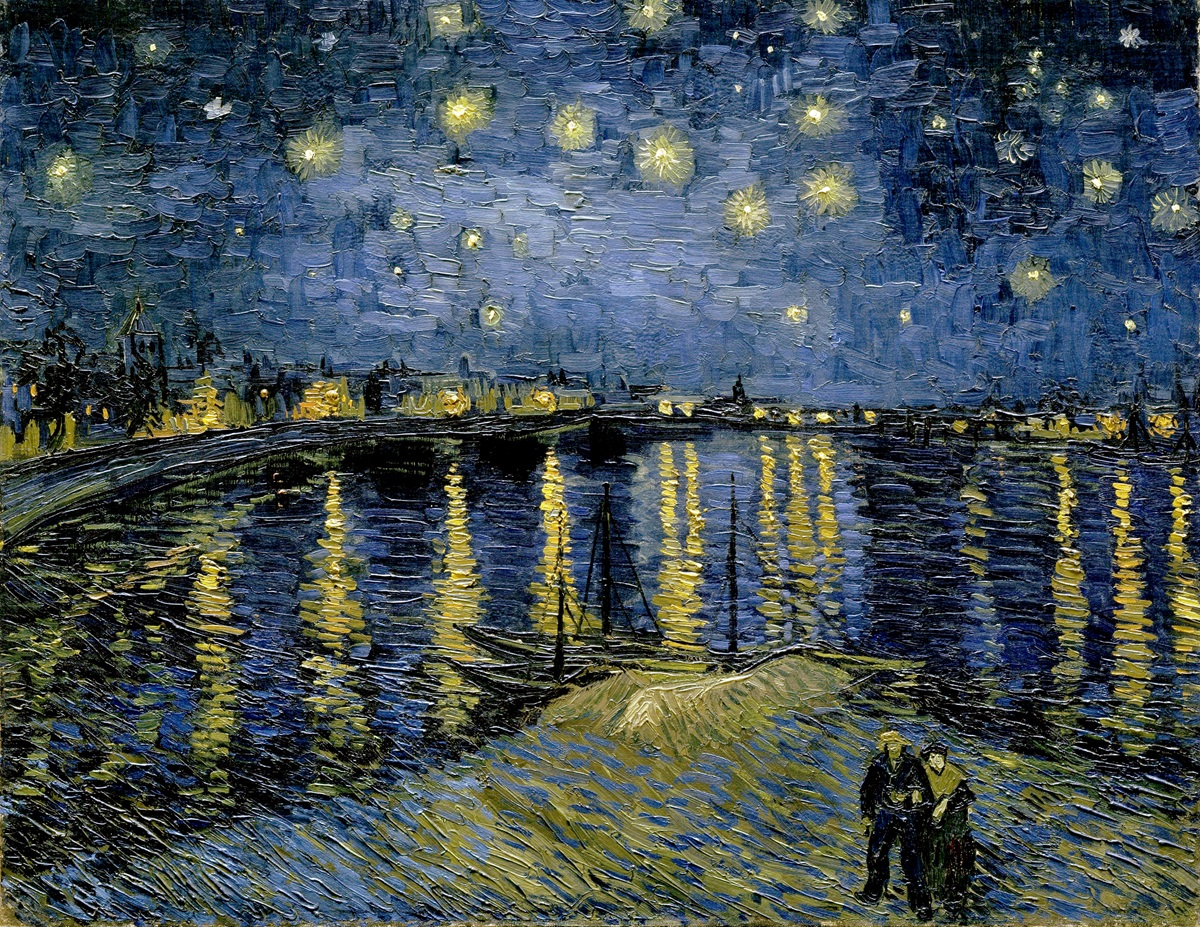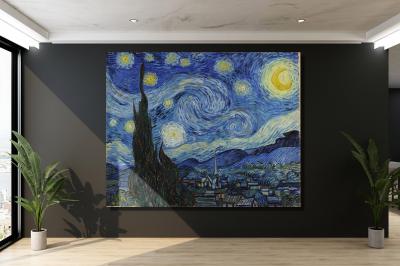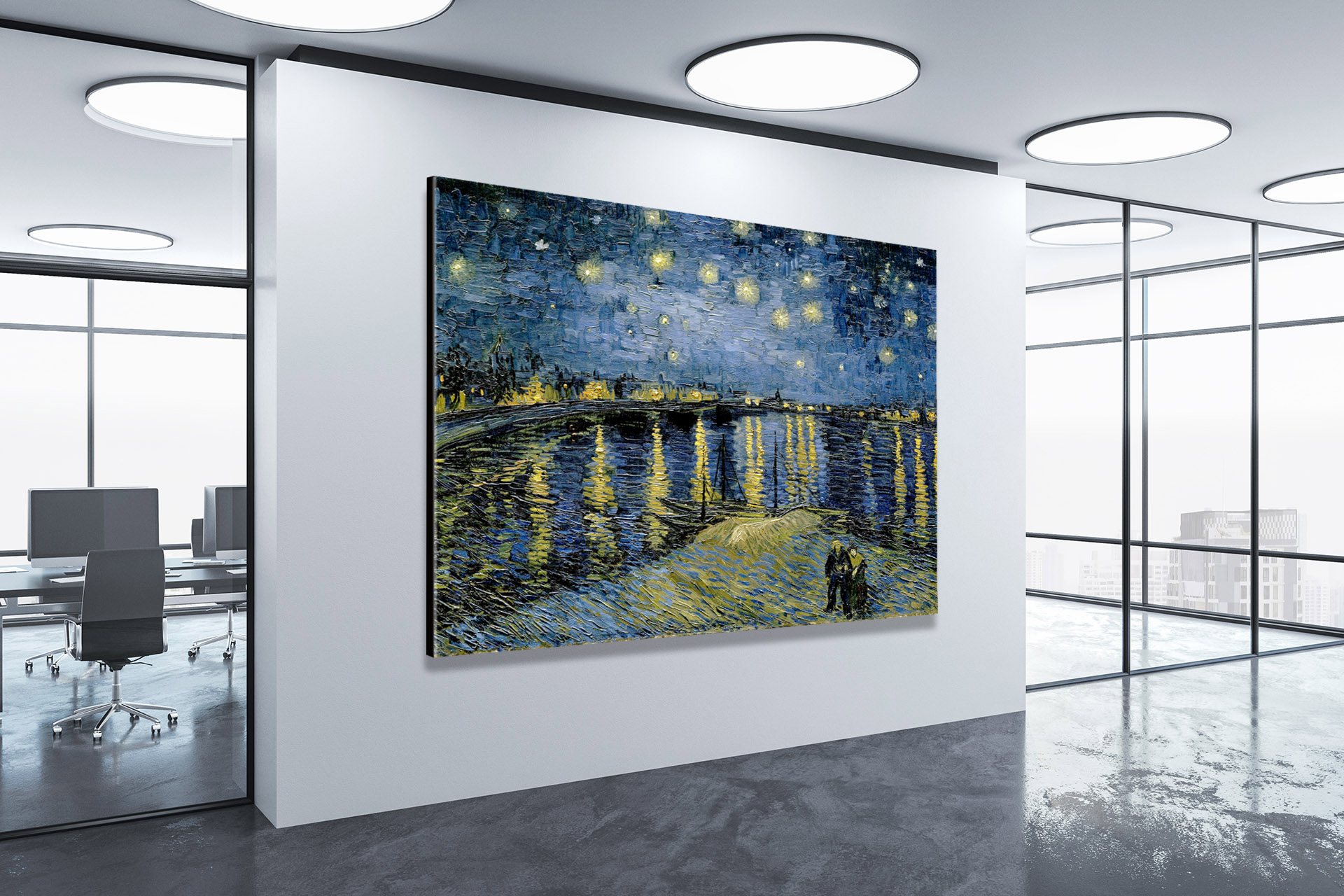Starry Night over the Rhone
By Vincent van Gogh, 1888
Starry Night over the Rhone Vincent van Gogh’s Enigmatic Celestial Ode
The name Vincent van Gogh conjures visions of passion, intrigue, and an indomitable creative spirit that has left an indelible mark on the world of art. Within the tumultuous tapestry of his life, marked by mental health battles and financial strife, his paintings remain timeless relics of his genius. Among these treasures, “Starry Night over the Rhone” emerges as a celestial masterpiece, a confirmation to van Gogh’s unwavering artistic vision. Join us as we embark on an in-depth exploration of this iconic work, which immerses us in a serene yet electrifying night along the banks of the Rhone River, while also diving into the technical challenges faced by the artist and the significance of its location. Finally, we will take a closer look at the life and artistic journey of the brilliant painter, Vincent van Gogh.
The Enigmatic Rhone’s Allure
Painted in September 1888 during van Gogh’s residence in Arles, France, “Starry Night over the Rhone” encapsulates the artist’s profound fascination with the region’s landscapes. Arles, a town nestled in the picturesque South of France, provided a wealth of inspiration for van Gogh, and the Rhone River, with its gentle flow and idyllic surroundings, became a recurring motif in his work during this period. In this masterpiece, van Gogh invites us to share in the enchantment of a warm, autumnal night, where the night sky envelops the river, and the entire scene is bathed in a surreal luminosity.
“Starry Night over the Rhone” Large Canvas Prints from WhiteClouds
Technical Challenges and Innovations
“Starry Night over the Rhone” showcases van Gogh’s daring technical innovations and his unyielding commitment to pushing the boundaries of artistic expression. The painting is characterized by its bold use of color, swirling brushwork, and a captivating interplay of light and dark. These elements combined to create a canvas that challenges the conventions of his time, inviting viewers to immerse themselves in the artist’s emotional and sensory experience.
One of the notable technical challenges van Gogh faced was capturing the radiance of the stars and the reflections on the water’s surface. To achieve this, he utilized impasto, a technique involving the thick application of paint to create texture and depth. The impasto technique allowed van Gogh to sculpt the stars and their reflections, making them appear almost three-dimensional, and imbuing them with an otherworldly luminosity. This meticulous approach brought the night sky to life and made the stars seem to sparkle with an inner light, a testament to van Gogh’s technical prowess.
The Celestial Ballet of Elements
Central to the painting’s allure is its celestial display. Van Gogh’s stars shine with an almost otherworldly intensity, their golden luminescence piercing through the profound, velvety blue of the night sky. Each star possesses its unique character, twinkling and pirouetting across the canvas in an enthralling cosmic ballet. This celestial symphony is a testament to van Gogh’s extraordinary ability to capture the ineffable, translating the grandeur of the night sky into the realm of the tangible.
The Enigmatic River’s Role
While the stars take center stage, the Rhone River is an equally compelling character in this masterpiece. Its placid surface serves as a canvas for the heavenly spectacle above, creating a mesmerizing interplay of light and shadow. Van Gogh’s meticulous attention to detail in portraying the reflections on the water’s surface speaks to his unwavering commitment to encapsulating the essence of the moment. The river’s deep, inky depths juxtaposed against the radiant night sky create a dramatic visual tension that propels the painting to new heights.
The Human Element
In the foreground of “Starry Night over the Rhone,” van Gogh thoughtfully includes a couple strolling along the riverbank. These figures, rendered in simple, dark silhouettes, appear dwarfed by the vast cosmic display overhead. However, their presence adds an intimate and emotional dimension to the scene, reminding us that even amidst the grandeur of the universe, the human connection endures. Van Gogh’s inclusion of these figures invites us to reflect on the enduring power of love and human connection in the face of the cosmic unknown.
Vincent van Gogh: The Painter’s Odyssey
Vincent van Gogh’s life was a tumultuous odyssey marked by emotional turbulence. Born in 1853 in the Netherlands, he pursued various careers before discovering his passion for art. His artistic journey was a whirlwind of self-discovery, experimentation, and innovation. Van Gogh’s works evolved from dark, somber tones to vibrant, expressive bursts of color, mirroring the ebbs and flows of his mental and emotional states.
Despite facing personal hardships and mental health challenges, van Gogh’s dedication to his craft never wavered. His unwavering commitment to pushing the boundaries of artistic expression led to the creation of iconic masterpieces like “Starry Night over the Rhone” and “The Starry Night.”
Tragically, van Gogh’s life was cut short when he passed away in 1890 at the age of 37. However, his artistic legacy endures, inspiring generations of artists and art enthusiasts alike. His ability to translate raw emotion and his unique perspective on the world into visual art has left an indelible mark on the art world, and his paintings continue to captivate and move people around the globe.
 Starry Night over the Rhone by Vincent van Gogh
Starry Night over the Rhone by Vincent van Gogh
Conclusion
“Starry Night over the Rhone” stands as a cornerstone of Vincent van Gogh’s oeuvre, cherished and revered for its magnetic blend of color, emotion, and celestial wonder. As we immerse ourselves in this masterpiece, we are beckoned to ponder the eternal mysteries of the universe and the poignant beauty of the human spirit. It serves as an enduring confirmation to van Gogh’s extraordinary ability to transform the ordinary into the extraordinary, inviting us to share in the artist’s profound connection to the cosmos. In this timeless painting, we discover not only a celestial masterpiece but also a portal to the deepest recesses of van Gogh’s heart and soul, all while appreciating the technical challenges he overcame and the significance of the Rhone’s location in shaping this mesmerizing work of art. Vincent van Gogh’s artistic journey, marked by determination and an unwavering commitment to self-expression, serves as an inspirational legacy that continues to enrich our understanding of the human experience and the boundless potential of art.
Frequently Asked Questions About “Starry Night over the Rhone”
What is the significance of “Starry Night over the Rhone” in Vincent van Gogh’s body of work? “Starry Night over the Rhone” is a significant work in van Gogh’s oeuvre as it represents his exploration of the night sky, an aspect he revisited in other works such as “The Starry Night.” It showcases his use of bold colors, swirling forms, and emotional intensity.
Where and when was “Starry Night over the Rhone” painted? The painting was created by van Gogh in Arles, France, in September 1888, during his productive period in the South of France.
Why did Vincent van Gogh choose the Rhone River as the subject for this painting? Van Gogh was captivated by the scenic beauty of the Rhone River, which offered him a stunning backdrop for his exploration of the night sky. The location provided him with the perfect setting to experiment with light and color.
What were the technical challenges faced by van Gogh while creating this masterpiece? Van Gogh encountered technical challenges in capturing the luminosity of stars and their reflections on water. He overcame these challenges by using impasto technique to sculpt stars and their reflections, creating a three-dimensional effect.
Can you explain the symbolism behind the stars and the night sky in the painting? The stars and the night sky in the painting symbolize the vastness of the universe and the transcendent beauty of nature. They also reflect van Gogh’s emotional and spiritual yearning.
How did van Gogh achieve the luminous quality of the stars and their reflections on the water? Van Gogh achieved the luminous quality of the stars through the use of thickly applied impasto, which created texture and depth. This technique allowed the stars to appear as if they were glowing.
Are the stars in “Starry Night over the Rhone” scientifically accurate, or did van Gogh take artistic liberties? Van Gogh took artistic liberties with the depiction of stars, as they are more expressive and symbolic than scientifically accurate. His goal was to convey an emotional and spiritual experience rather than astronomical precision.
What is the significance of the couple in the foreground of the painting? The couple in the foreground adds a human element to the painting, emphasizing the enduring power of love and human connection in the face of the vast, mysterious universe depicted above.
How did Vincent van Gogh’s mental state and personal life influence the creation of this artwork? Van Gogh’s mental struggles and personal life deeply influenced his art. “Starry Night over the Rhone” reflects his inner turmoil and his longing for beauty and connection, even in the midst of personal challenges.
What is the current location of “Starry Night over the Rhone”? Is it part of a public collection? “Starry Night over the Rhone” is part of the collection at the Musée d’Orsay in Paris, France, and is accessible to the public.
How does “Starry Night over the Rhone” compare to van Gogh’s other famous work, “The Starry Night”? “Starry Night over the Rhone” predates “The Starry Night” and is a more serene and realistic portrayal of a night sky. “The Starry Night,” on the other hand, is a more abstract and emotional representation.
What is the emotional impact and message conveyed by this painting? The emotional impact of the painting lies in its evocative beauty and the sense of wonder it instills. It conveys the idea of finding solace and beauty in the midst of life’s challenges.
Has “Starry Night over the Rhone” been the subject of any famous exhibitions or art controversies? While it may not be as controversial as some of van Gogh’s other works, “Starry Night over the Rhone” has been featured in many exhibitions celebrating the artist’s life and work.
What inspired van Gogh to create this particular composition, and did he have any specific goals or intentions with it? Van Gogh’s inspiration for the painting came from the beauty of the night sky over the Rhone River. His goal was to capture the emotional and spiritual experience of that moment.
How has the interpretation and reception of “Starry Night over the Rhone” evolved over time? The interpretation of the painting has evolved from an appreciation of its beauty to a deeper understanding of its connection to van Gogh’s emotions and struggles. It is now seen as a symbol of artistic resilience.
Are there any interesting anecdotes or stories associated with the creation of this artwork? While there are no specific anecdotes related to the creation of this painting, van Gogh’s letters to his brother Theo provide insights into his thoughts and feelings during his time in Arles and his fascination with the night sky.
What techniques and materials did van Gogh use in creating “Starry Night over the Rhone”? Van Gogh used oil paints on canvas and applied them with bold brushwork and impasto technique to create texture and depth.
How does the location of the painting’s creation in Arles, France, influence its significance? Arles was a place of great inspiration for van Gogh, and the location of the painting’s creation adds to its significance, as it reflects the artist’s deep connection to the landscapes and culture of the South of France.
What are some notable artistic influences and references present in the painting? While van Gogh was influenced by the Impressionist movement and artists like Émile Bernard and Paul Gauguin during his time in Arles, “Starry Night over the Rhone” is primarily an expression of his unique style and vision.
Can you recommend any books or resources for further exploration of “Starry Night over the Rhone” and Vincent van Gogh’s life and art? Some recommended resources for further exploration include “Van Gogh: The Life” by Steven Naifeh and Gregory White Smith, and “The Letters of Vincent van Gogh” edited by Mark Roskill. Additionally, visiting the Musée d’Orsay in Paris provides a firsthand experience of the painting.
Other Articles on Vincent van Gogh Paintings
At Eternities Gate by Vincent Van Gogh, 1890
Blossoming Almond Tree by Vincent Van Gogh, 1890
Cafe Terrace at Night by Vincent Van Gogh, 1888
Daubigneys Garden by Vincent Van Gogh, 1890
Green Wheat Field with Cypress by Vincent Van Gogh, 1889
Houses at Auvers by Vincent Van Gogh, 1890
Irises by Vincent Van Gogh, 1889
Night Café by Vincent Van Gogh, 1888
Portrait of Dr. Gachet by Vincent Van Gogh, 1890
Red Vineyards by Vincent Van Gogh, 1888
Road with Cypress and Star by Vincent Van Gogh, 1890
Starry Night by Vincent Van Gogh, 1889
Starry Night over the Rhone by Vincent Van Gogh, 1888
Sunflowers by Vincent Van Gogh, 1887
The Bedroom by Vincent Van Gogh, 1888
The Church at Aurers by Vincent Van Gogh, 1890
The Garden of the Asylum by Vincent Van Gogh, 1889
The Mulberry Tree by Vincent Van Gogh, 1889
The Potato Eaters by Vincent Van Gogh, 1885
The Yellow House by Vincent Van Gogh, 1888
Tree Roots by Vincent Van Gogh, 1890
Van Gogh Self Portrait by Vincent Van Gogh, 1887
Vase with Red Poppies by Vincent Van Gogh, 1886
View of Arles by Vincent Van Gogh, 1889
Wheat Field with Crows by Vincent Van Gogh, 1890
Wheat Field with Cypresses by Vincent Van Gogh, 1889
More WhiteClouds Videos
Contact us today to learn more about our 3D services and how we can help you achieve your goals.

